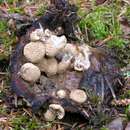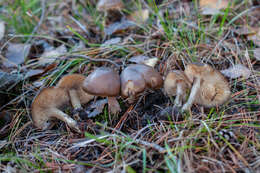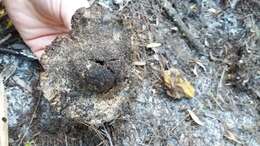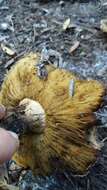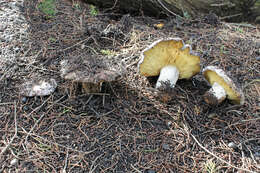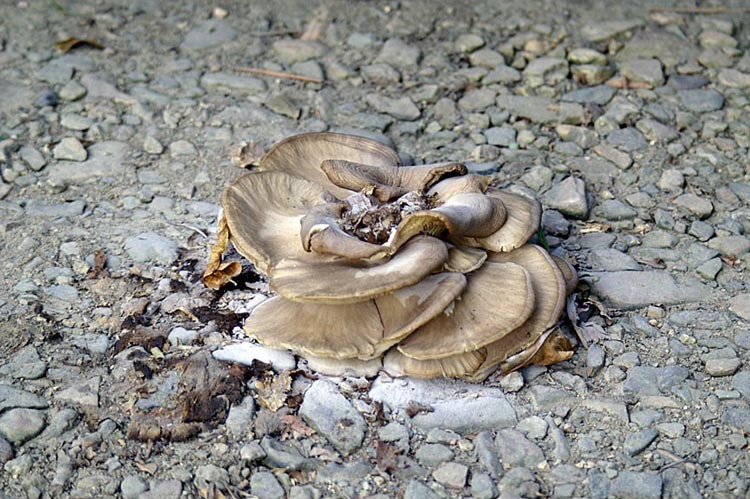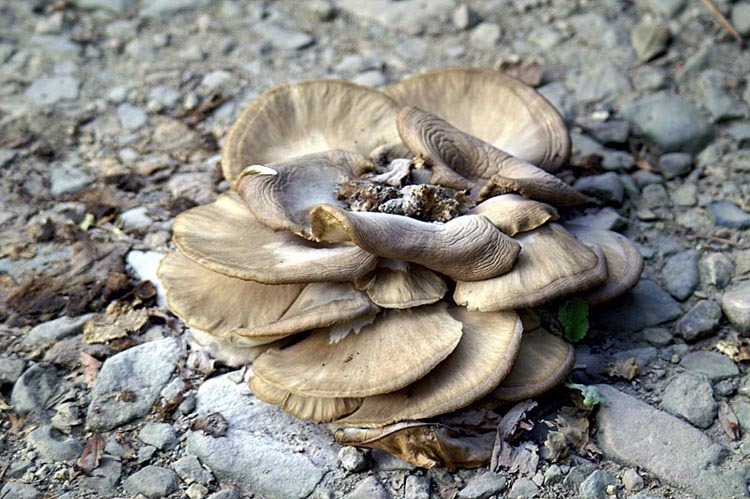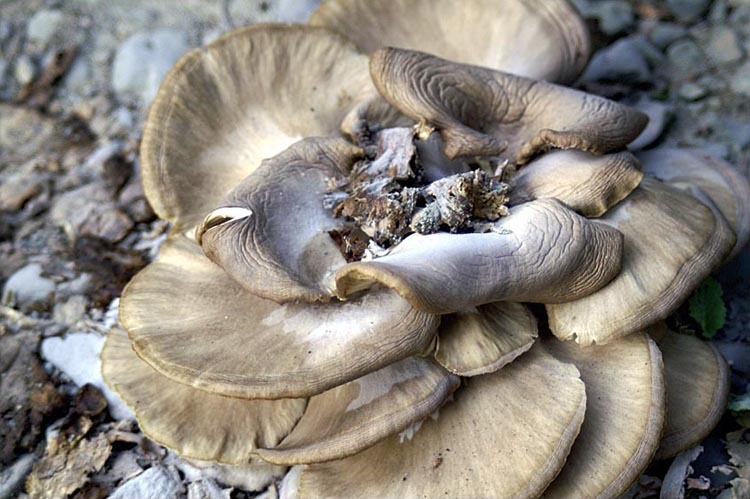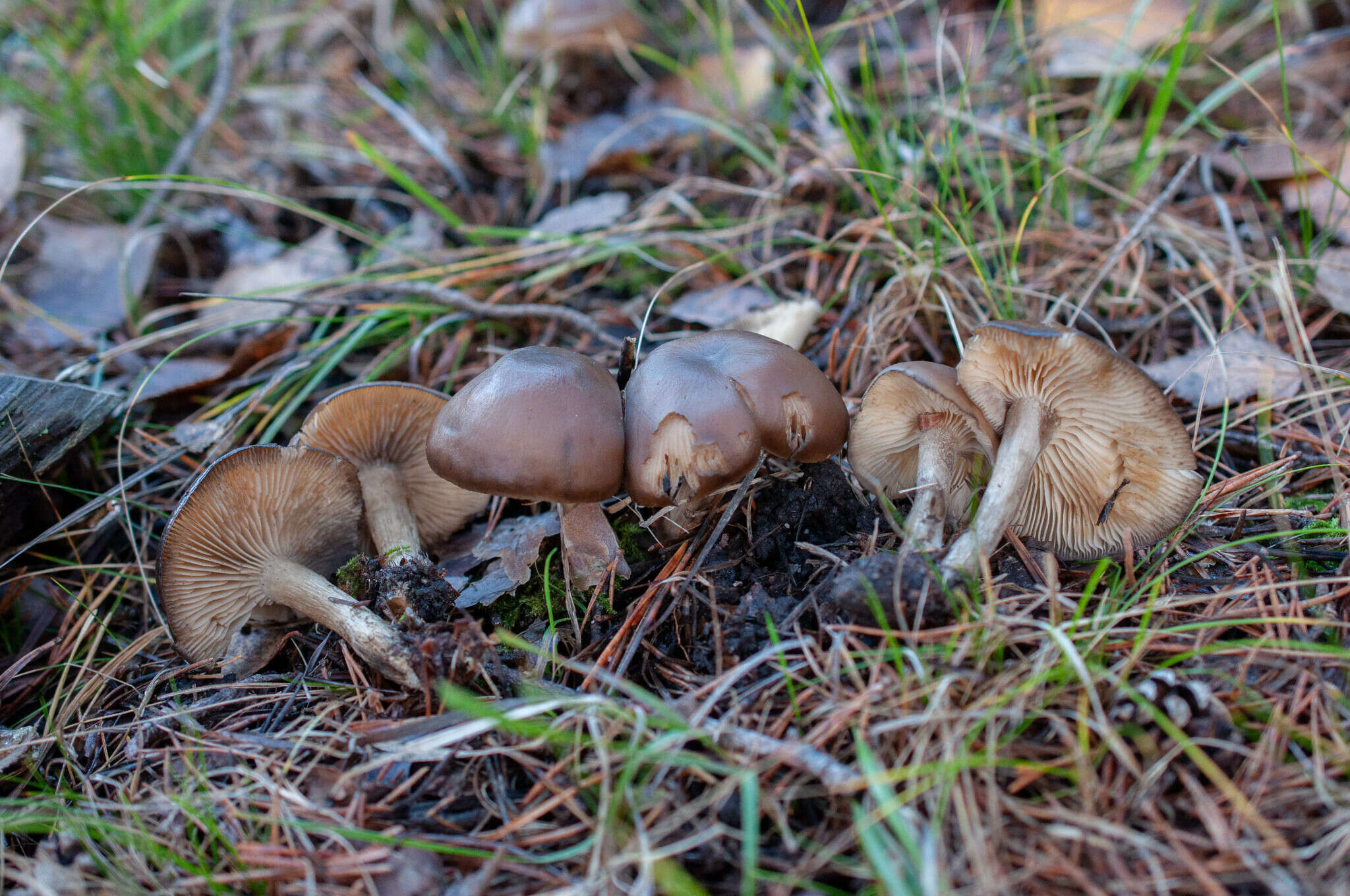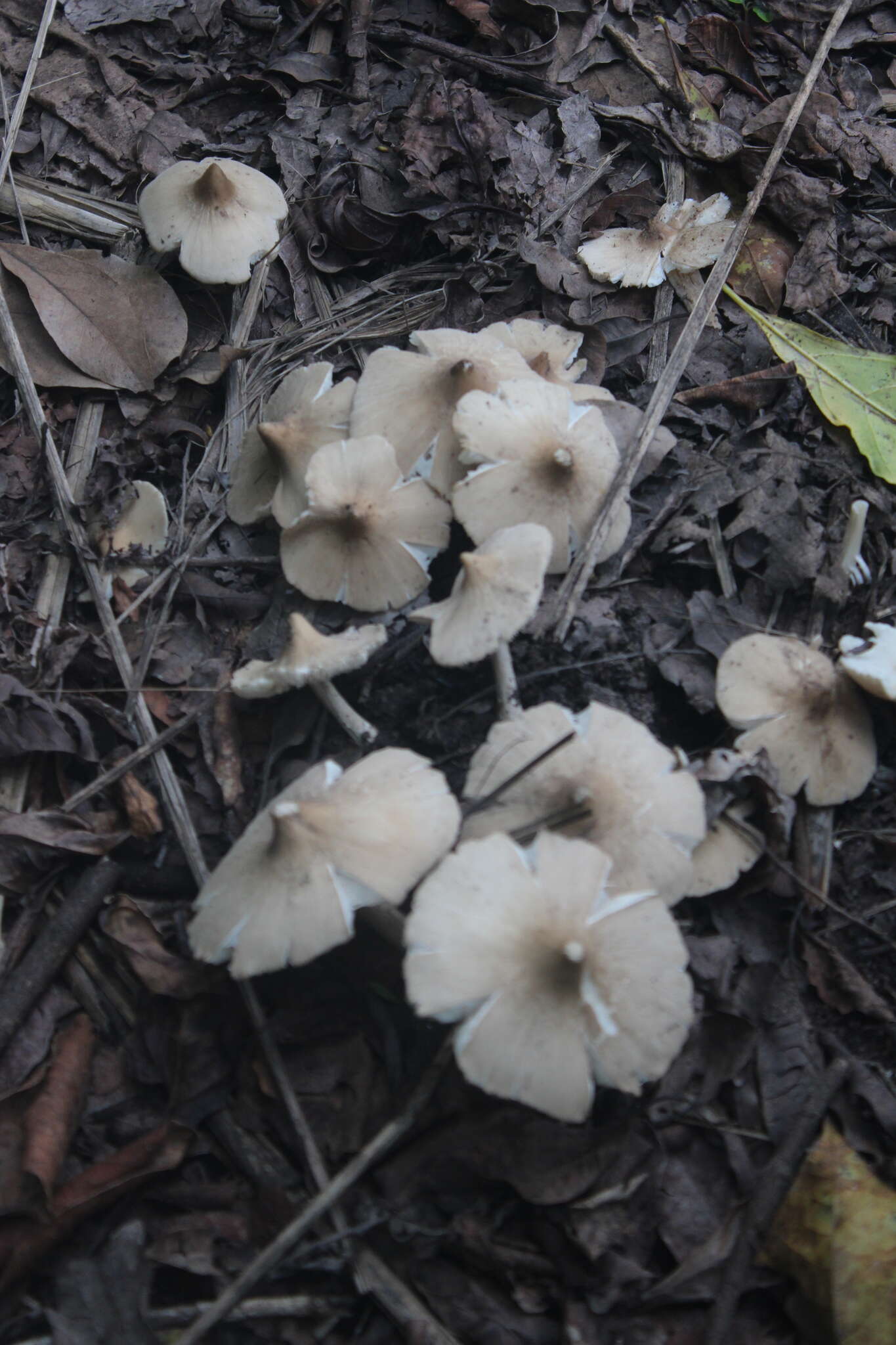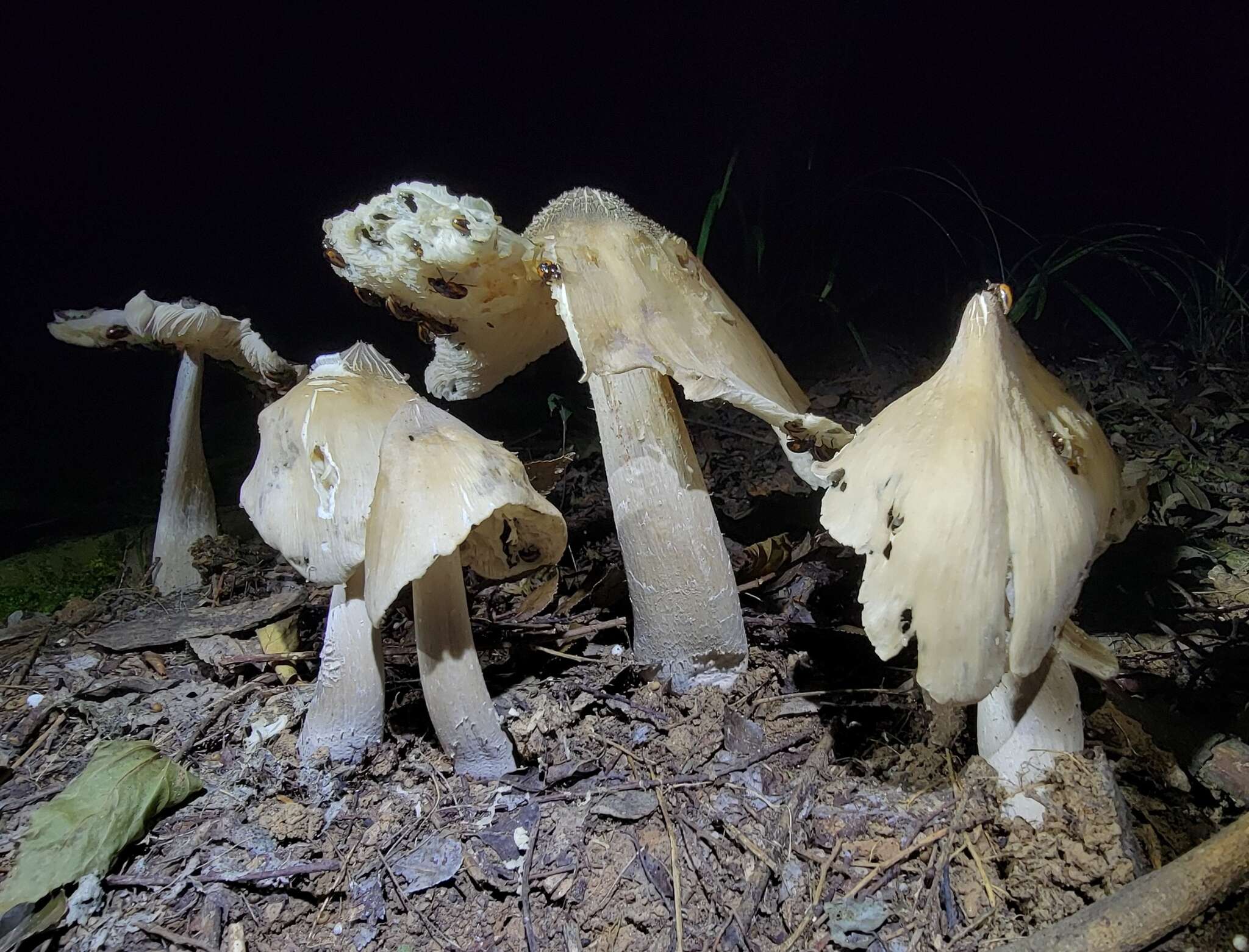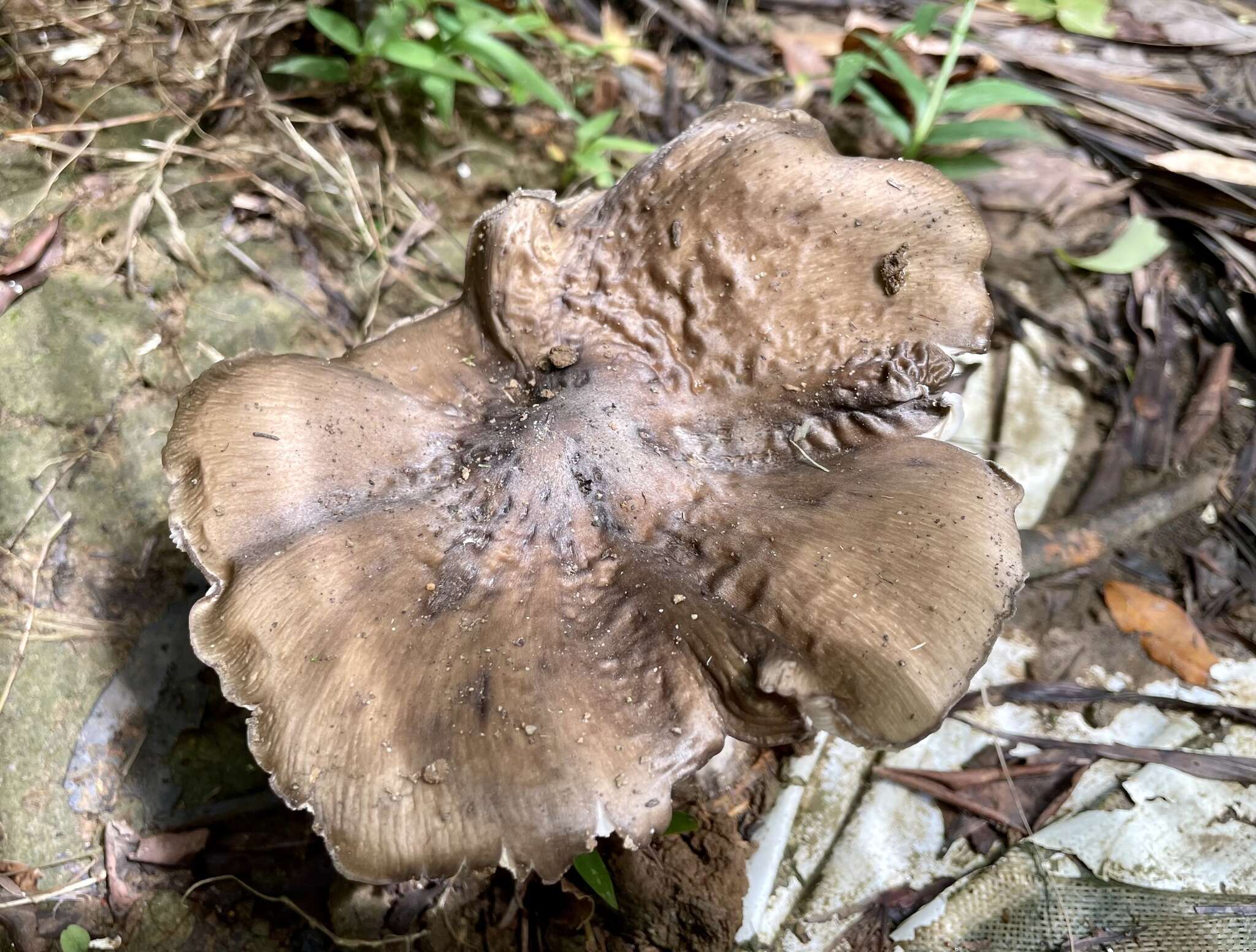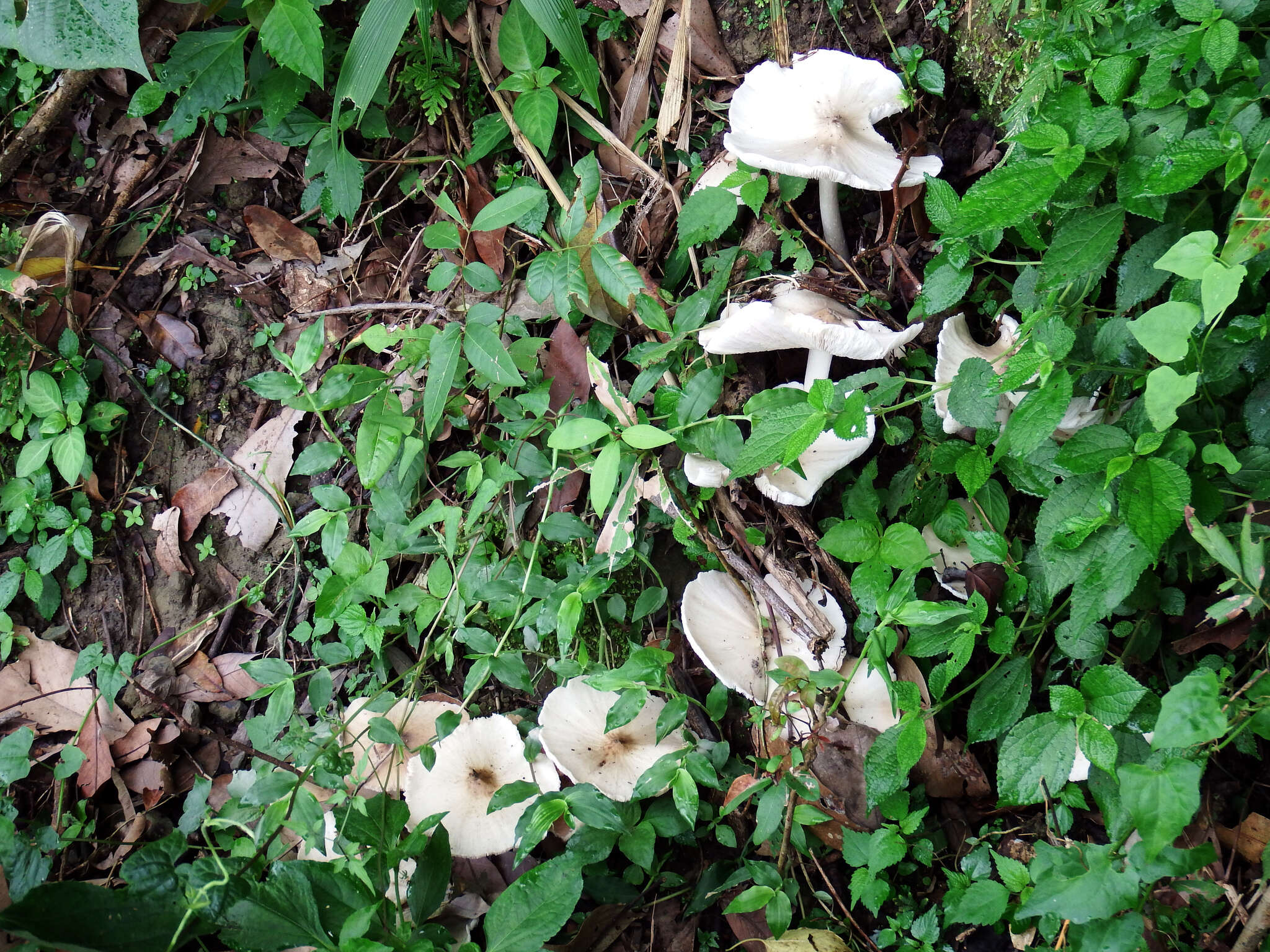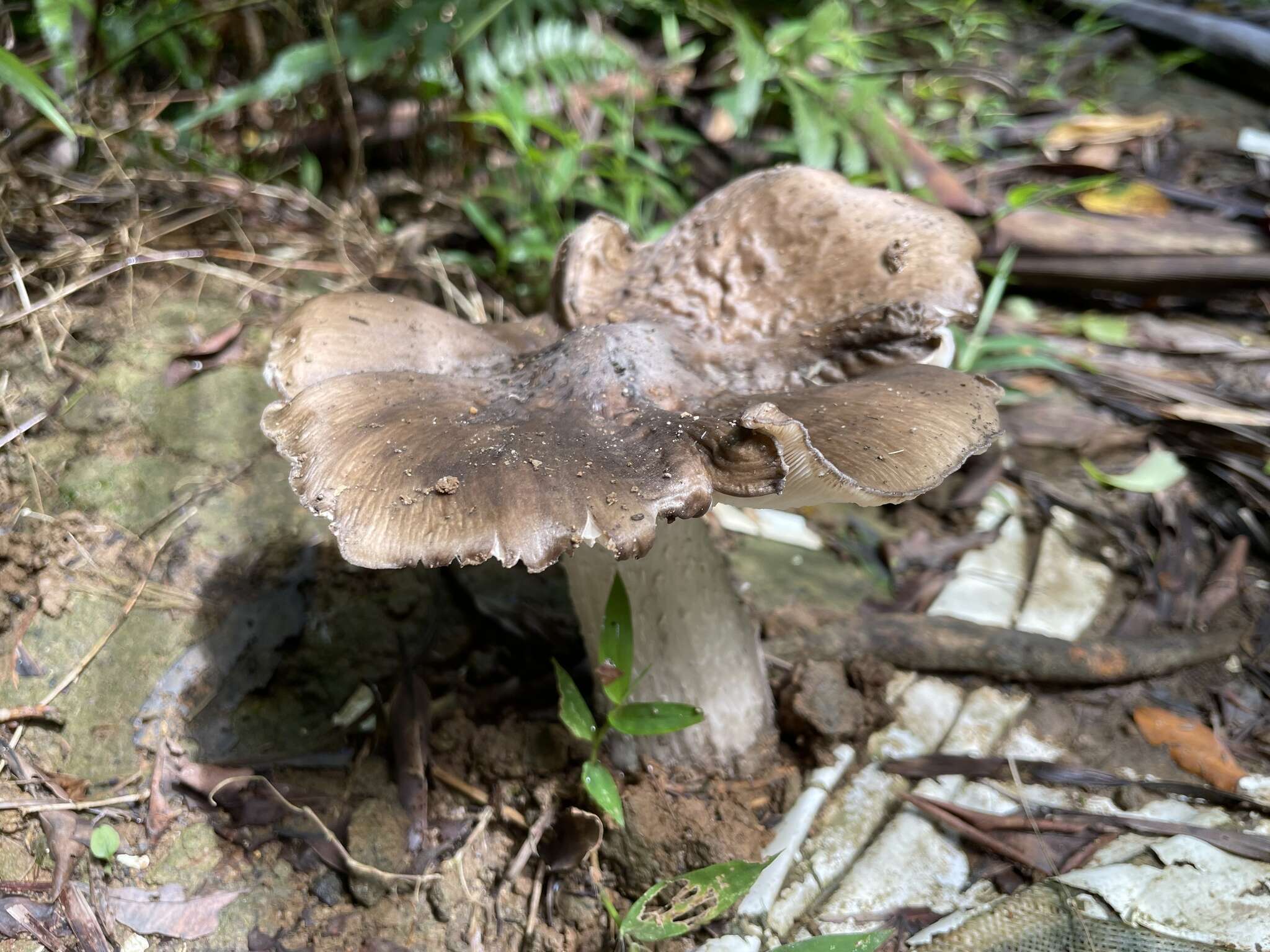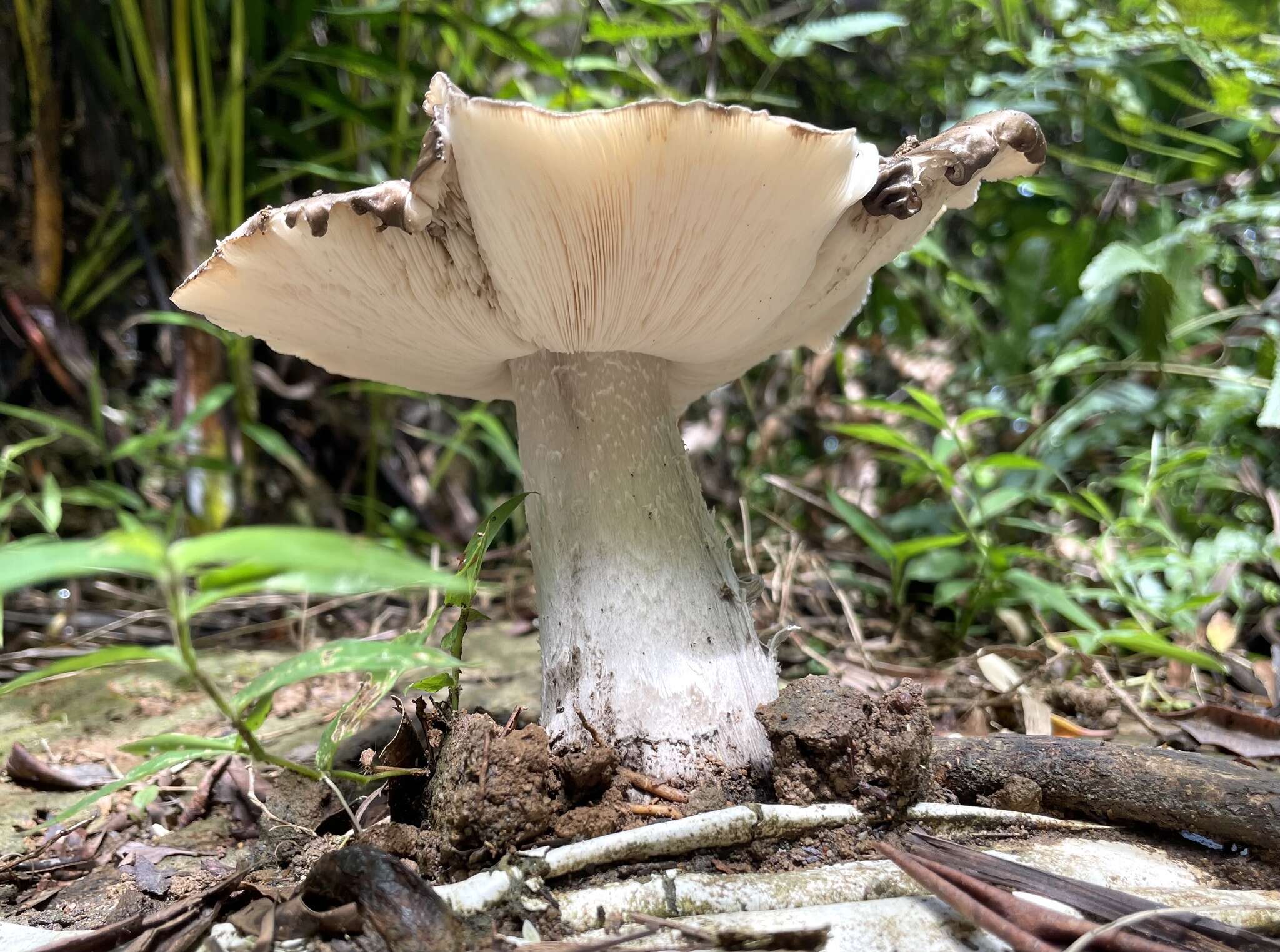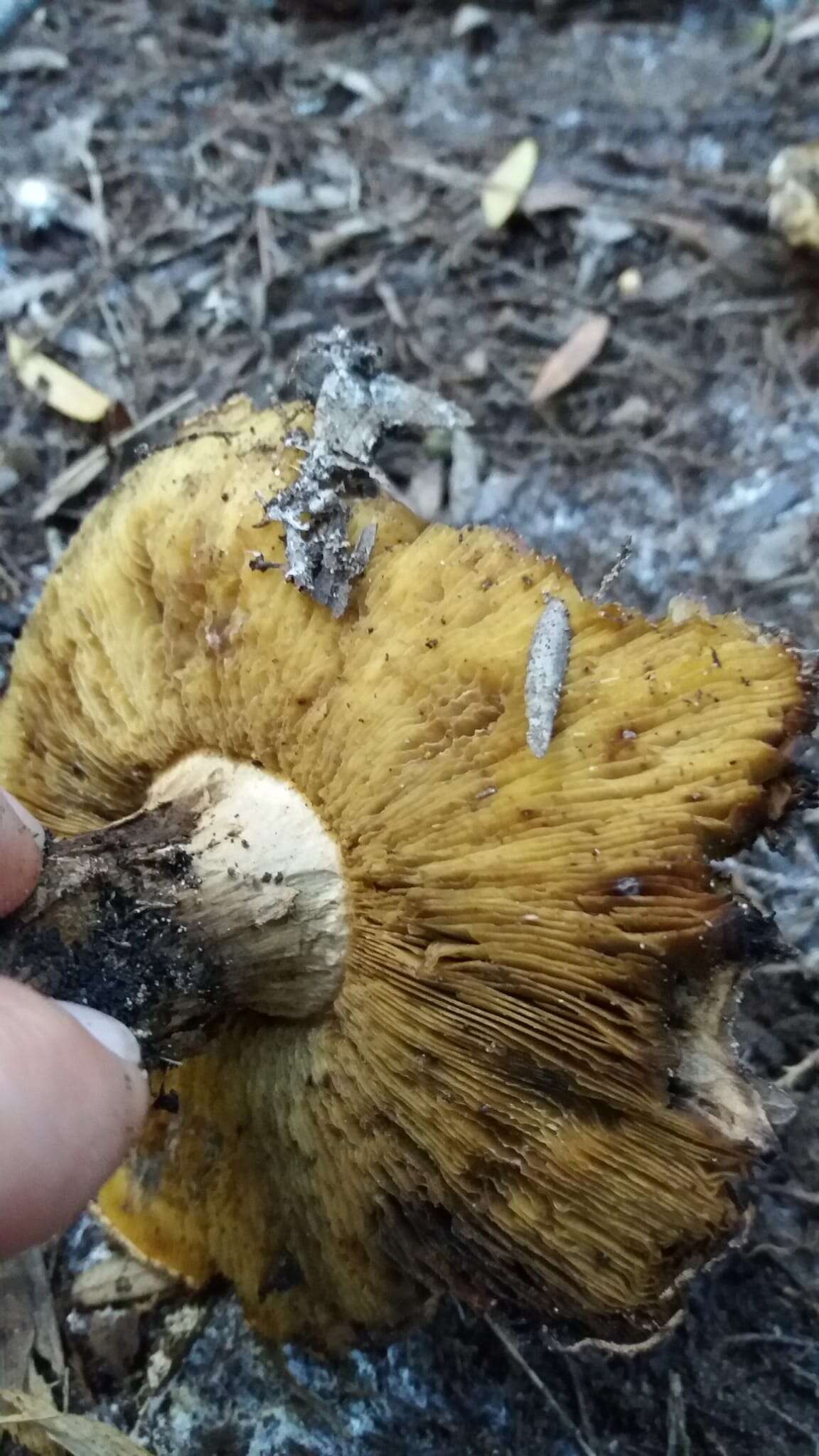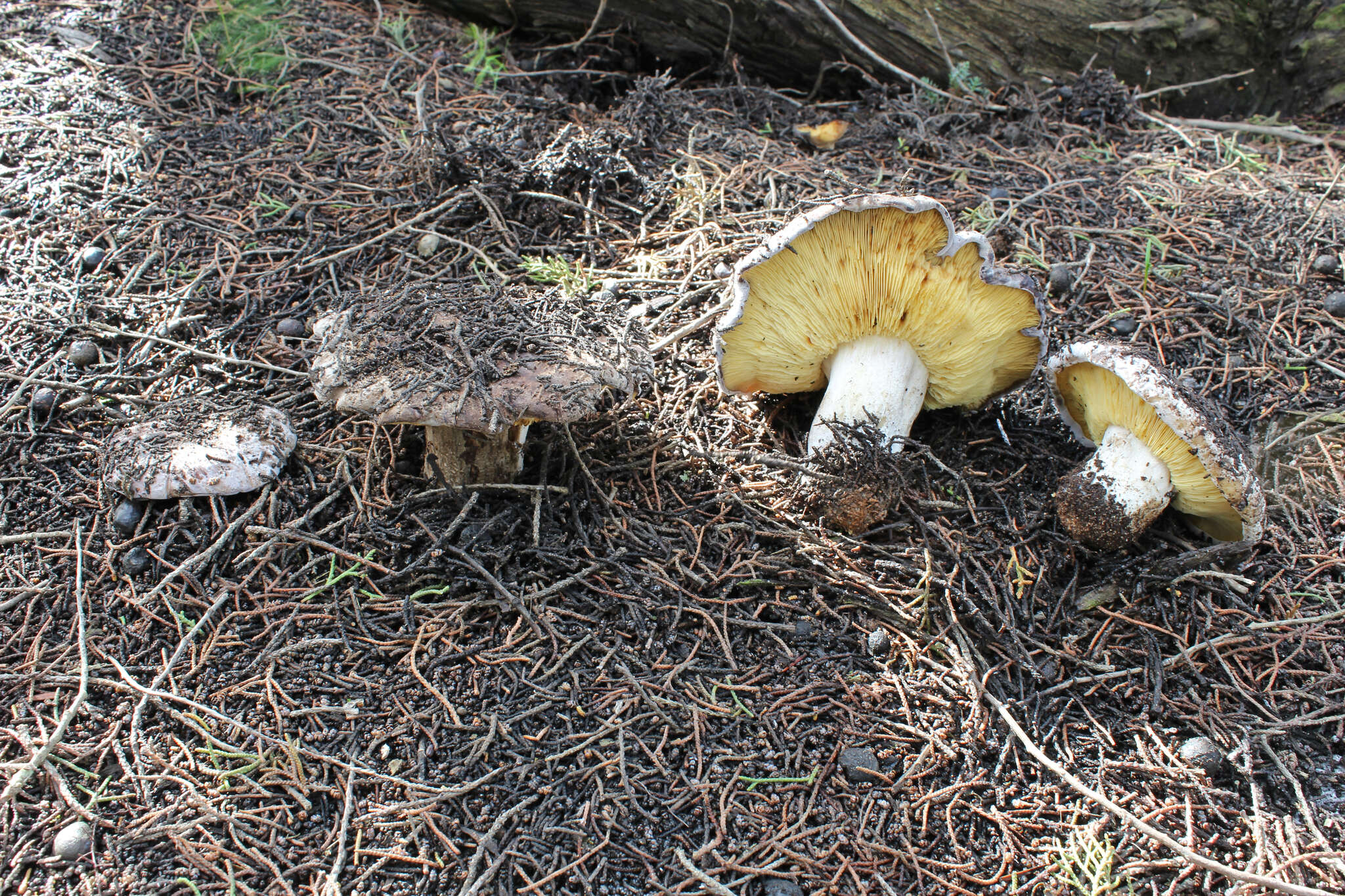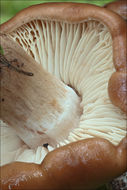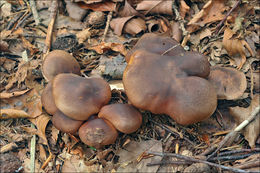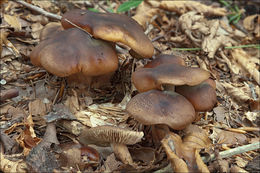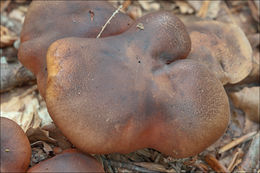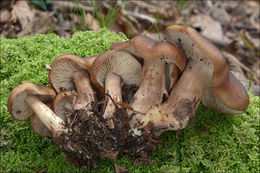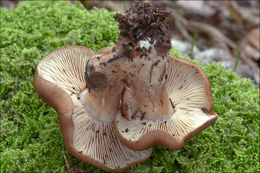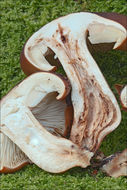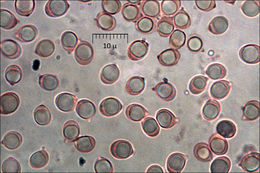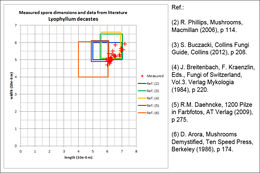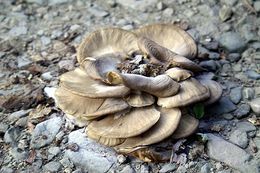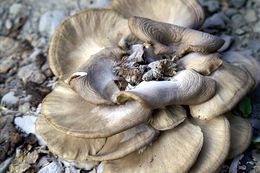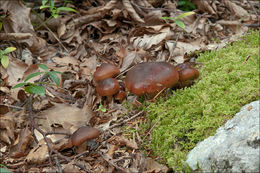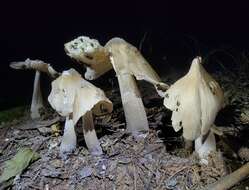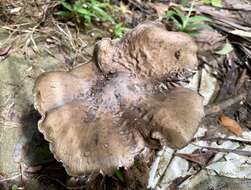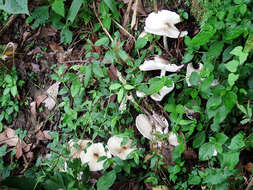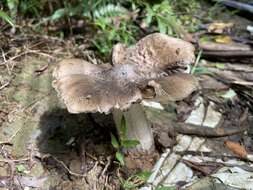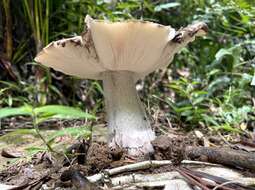-
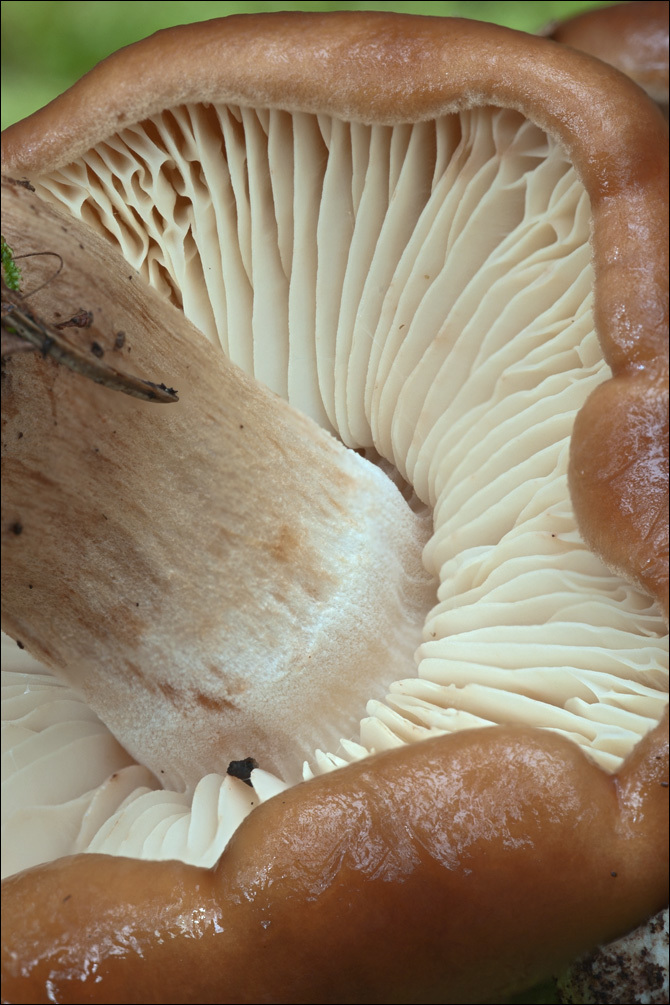
Slo.: rjavi zajek - syn.: Lyophyllum fumosum (Pers: Fr.) Orton, Lyophyllum loricatum (Fr.Khner), Lyophyllum aggregatum (Schaeffer) Khner, Lyophyllum conglobatum (Vit.) Moser, Lyophyllum cinerascens (Buill.) Giller - Habitat: mixed wood, Fagus sylvatica and Picea abies dominant trees; modestly steep, SE oriented mountain slope; shallow, skeletal soil layer, overgrown calcareous sand, stone and rocks; relatively dry and warm place; in shade; partly protected from direct rain by tree canopies; average precipitations ~ 3.000 mm/year, average temperature 7-9 deg C, elevation 600 m (1.970 feet), alpine phytogeographical region. - Substratum: forest soil. - Comments: Growing in groups of several fruit bodies on two places some 100 m apart (see also observation Bot_838/2014_DSC4296 in the same day); pileus diameter up to 5 cm, viscid with young fruit bodies; cuticle thick, rubbery, peels easily; stipe up to 4 cm tall and 1.4 cm in diameter; sporocarps markedly fleshy and firm; taste mild, mushroomy; smell indistinctive, almost none; SP abundant but only after two days of collecting, yellowish-beige with slight green tint, oac13. - Spores smooth, subglobose. Dimensions: 5.8 [6.3 ; 6.6] 7.1 x 4.6 [5.1 ; 5.3] 5.8 microns; Q = 1.2 [1.23 ; 1.26] 1.3; N = 37; C = 95%; Me = 6.5 x 5.2 microns; Qe = 1.2. Olympus CH20, NEA 100x/1.25, magnification 1.000 x, oil, in water, Congo red; live material. AmScope MA500 digital camera. - Ref.: (1) G.J. Krieglsteiner (Hrsg.), Die Grosspilze Baden-Wrttembergs, Band 3., Ulmer (2001), p 307. (2) R. Phillips, Mushrooms, Macmillan (2006), p 114. (3) S. Buczacki, Collins Fungi Guide, Collins (2012), p 208. (4) J. Breitenbach, F. Kraenzlin, Eds., Fungi of Switzerland, Vol.3. Verlag Mykologia (1984), p 220. (5) R.M. Daehncke, 1200 Pilze in Farbfotos, AT Verlag (2009), p 275. S 5-6 (6) D. Arora, Mushrooms Demystified, Ten Speed Press, Berkeley (1986), p 174.
-
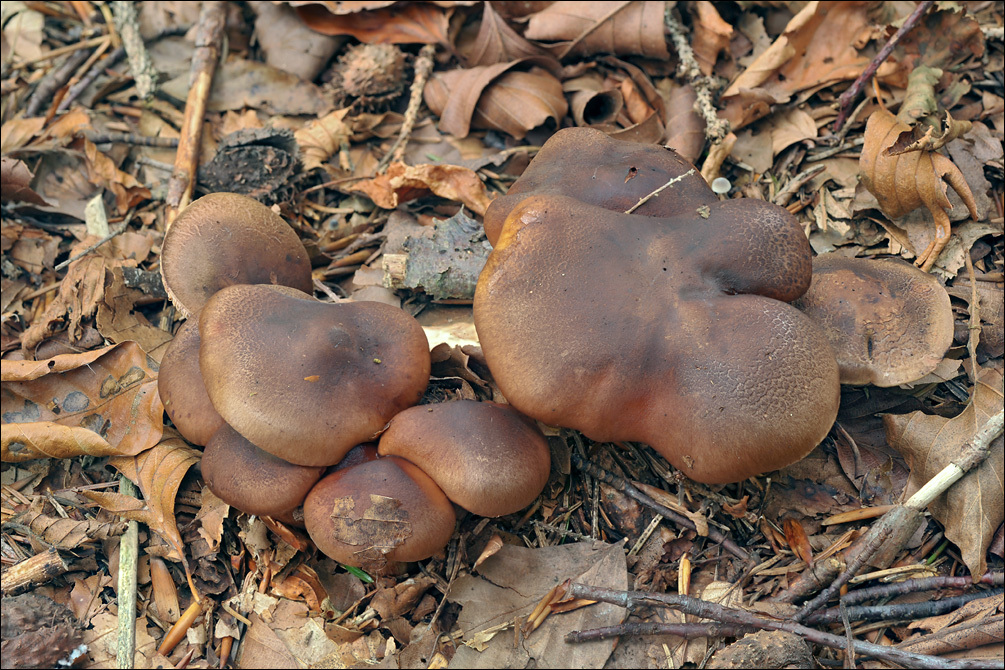
Slo.: rjavi zajek - syn.: Lyophyllum fumosum (Pers: Fr.) Orton, Lyophyllum loricatum (Fr.Khner), Lyophyllum aggregatum (Schaeffer) Khner, Lyophyllum conglobatum (Vit.) Moser, Lyophyllum cinerascens (Buill.) Giller - Habitat: mixed wood, Fagus sylvatica and Picea abies dominant trees; modestly steep, SE oriented mountain slope; shallow, skeletal soil layer, overgrown calcareous sand, stone and rocks; relatively dry and warm place; in shade; partly protected from direct rain by tree canopies; average precipitations ~ 3.000 mm/year, average temperature 7-9 deg C, elevation 585 m (1.920 feet), alpine phytogeographical region. - Substratum: forest soil, under Fagus sylvatica. - Comments: Lyophyllum decastes is actually an aggregate of quite differently looking mushrooms. Many species names have been used in this group. Authors still have different approach to them. I follow Krieglsteiner's view (Ref.2) (without my own arguments, but because it is the simplest for me), who considers Lyophyllum decastes, Lyophyllum fumosum, Lyophyllum loricatum, Lyophyllum aggregatum, Lyophyllum conglobatum and Lyophyllum cinerascens a single very variable species. Again and again fruit bodies are found with all possible intermediate properties forming an apparent continuum among these species. - Growing in groups of several fruit bodies on two places some 100 m apart (see also observation Bot_838/2014_DSC4273 in the same day); pileus diameter up to 5.2 cm, viscid with young fruit bodies; cuticle thick, rubbery, peels easily; stipe up to 4 cm tall and 1.5 cm in diameter; hollow with older fruit bodies; sporocarps markedly fleshy and firm; taste mild, mushroomy, after some time slightly bitter; smell indistinctive, almost none. - Herbarium: Mycotheca and lichen herbarium (LJU-Li) of Slovenian Forestry Institute, Vena pot 2, Ljubljana, Index Herbariorum LJF - Ref.: (1) G.J. Krieglsteiner (Hrsg.), Die Grosspilze Baden-Wrttembergs, Band 3., Ulmer (2001), p 307. (2) R. Phillips, Mushrooms, Macmillan (2006), p 114. (3) S. Buczacki, Collins Fungi Guide, Collins (2012), p 208. (4) J. Breitenbach, F. Kraenzlin, Eds., Fungi of Switzerland, Vol.3. Verlag Mykologia (1984), p 220. (5) R.M. Daehncke, 1200 Pilze in Farbfotos, AT Verlag (2009), p 275. (6) D. Arora, Mushrooms Demystified, Ten Speed Press, Berkeley (1986), p 174.
-
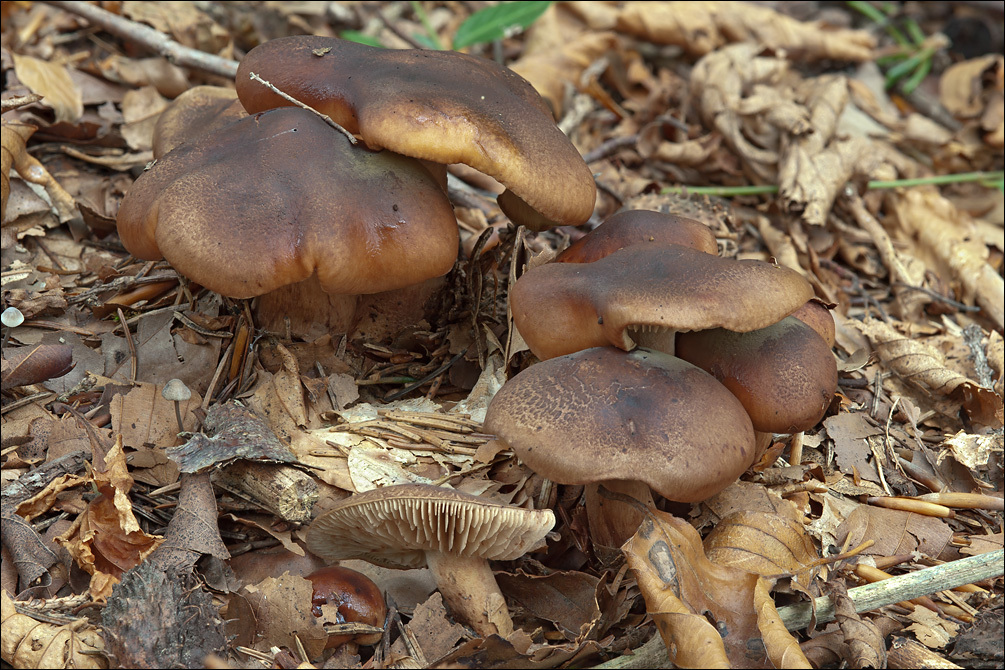
Slo.: rjavi zajek - syn.: Lyophyllum fumosum (Pers: Fr.) Orton, Lyophyllum loricatum (Fr.Khner), Lyophyllum aggregatum (Schaeffer) Khner, Lyophyllum conglobatum (Vit.) Moser, Lyophyllum cinerascens (Buill.) Giller - Habitat: mixed wood, Fagus sylvatica and Picea abies dominant trees; modestly steep, SE oriented mountain slope; shallow, skeletal soil layer, overgrown calcareous sand, stone and rocks; relatively dry and warm place; in shade; partly protected from direct rain by tree canopies; average precipitations ~ 3.000 mm/year, average temperature 7-9 deg C, elevation 585 m (1.920 feet), alpine phytogeographical region. - Substratum: forest soil, under Fagus sylvatica. - Comments: Lyophyllum decastes is actually an aggregate of quite differently looking mushrooms. Many species names have been used in this group. Authors still have different approach to them. I follow Krieglsteiner's view (Ref.2) (without my own arguments, but because it is the simplest for me), who considers Lyophyllum decastes, Lyophyllum fumosum, Lyophyllum loricatum, Lyophyllum aggregatum, Lyophyllum conglobatum and Lyophyllum cinerascens a single very variable species. Again and again fruit bodies are found with all possible intermediate properties forming an apparent continuum among these species. - Growing in groups of several fruit bodies on two places some 100 m apart (see also observation Bot_838/2014_DSC4273 in the same day); pileus diameter up to 5.2 cm, viscid with young fruit bodies; cuticle thick, rubbery, peels easily; stipe up to 4 cm tall and 1.5 cm in diameter; hollow with older fruit bodies; sporocarps markedly fleshy and firm; taste mild, mushroomy, after some time slightly bitter; smell indistinctive, almost none. - Herbarium: Mycotheca and lichen herbarium (LJU-Li) of Slovenian Forestry Institute, Vena pot 2, Ljubljana, Index Herbariorum LJF - Ref.: (1) G.J. Krieglsteiner (Hrsg.), Die Grosspilze Baden-Wrttembergs, Band 3., Ulmer (2001), p 307. (2) R. Phillips, Mushrooms, Macmillan (2006), p 114. (3) S. Buczacki, Collins Fungi Guide, Collins (2012), p 208. (4) J. Breitenbach, F. Kraenzlin, Eds., Fungi of Switzerland, Vol.3. Verlag Mykologia (1984), p 220. (5) R.M. Daehncke, 1200 Pilze in Farbfotos, AT Verlag (2009), p 275. (6) D. Arora, Mushrooms Demystified, Ten Speed Press, Berkeley (1986), p 174.
-
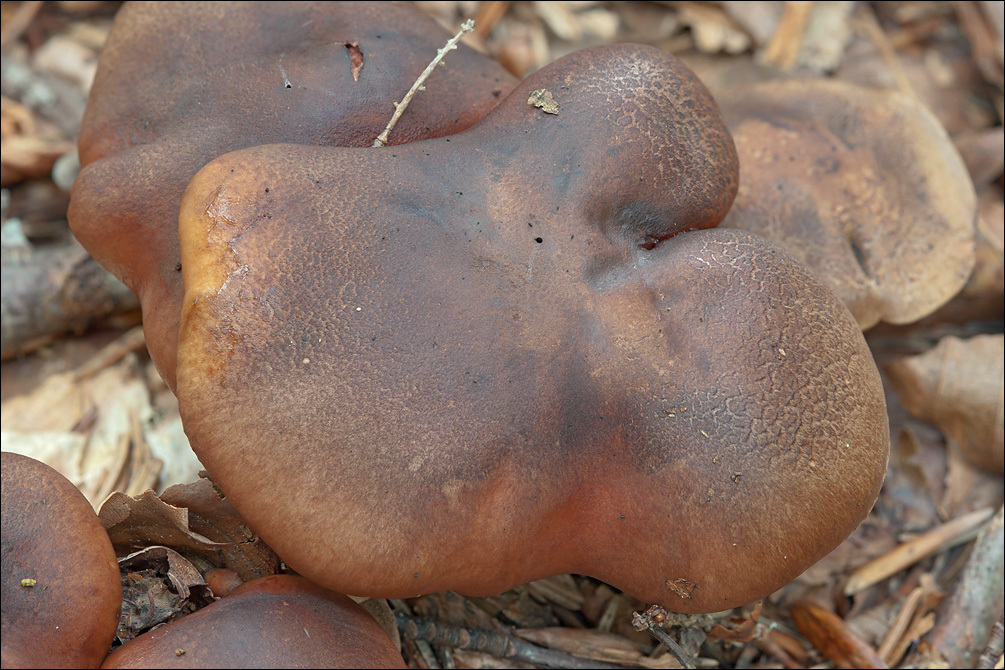
Slo.: rjavi zajek - syn.: Lyophyllum fumosum (Pers: Fr.) Orton, Lyophyllum loricatum (Fr.Khner), Lyophyllum aggregatum (Schaeffer) Khner, Lyophyllum conglobatum (Vit.) Moser, Lyophyllum cinerascens (Buill.) Giller - Habitat: mixed wood, Fagus sylvatica and Picea abies dominant trees; modestly steep, SE oriented mountain slope; shallow, skeletal soil layer, overgrown calcareous sand, stone and rocks; relatively dry and warm place; in shade; partly protected from direct rain by tree canopies; average precipitations ~ 3.000 mm/year, average temperature 7-9 deg C, elevation 585 m (1.920 feet), alpine phytogeographical region. - Substratum: forest soil, under Fagus sylvatica. - Comments: Lyophyllum decastes is actually an aggregate of quite differently looking mushrooms. Many species names have been used in this group. Authors still have different approach to them. I follow Krieglsteiner's view (Ref.2) (without my own arguments, but because it is the simplest for me), who considers Lyophyllum decastes, Lyophyllum fumosum, Lyophyllum loricatum, Lyophyllum aggregatum, Lyophyllum conglobatum and Lyophyllum cinerascens a single very variable species. Again and again fruit bodies are found with all possible intermediate properties forming an apparent continuum among these species. - Growing in groups of several fruit bodies on two places some 100 m apart (see also observation Bot_838/2014_DSC4273 in the same day); pileus diameter up to 5.2 cm, viscid with young fruit bodies; cuticle thick, rubbery, peels easily; stipe up to 4 cm tall and 1.5 cm in diameter; hollow with older fruit bodies; sporocarps markedly fleshy and firm; taste mild, mushroomy, after some time slightly bitter; smell indistinctive, almost none. - Herbarium: Mycotheca and lichen herbarium (LJU-Li) of Slovenian Forestry Institute, Vena pot 2, Ljubljana, Index Herbariorum LJF - Ref.: (1) G.J. Krieglsteiner (Hrsg.), Die Grosspilze Baden-Wrttembergs, Band 3., Ulmer (2001), p 307. (2) R. Phillips, Mushrooms, Macmillan (2006), p 114. (3) S. Buczacki, Collins Fungi Guide, Collins (2012), p 208. (4) J. Breitenbach, F. Kraenzlin, Eds., Fungi of Switzerland, Vol.3. Verlag Mykologia (1984), p 220. (5) R.M. Daehncke, 1200 Pilze in Farbfotos, AT Verlag (2009), p 275. (6) D. Arora, Mushrooms Demystified, Ten Speed Press, Berkeley (1986), p 174.
-

Slo.: rjavi zajek - syn.: Lyophyllum fumosum (Pers: Fr.) Orton, Lyophyllum loricatum (Fr.Khner), Lyophyllum aggregatum (Schaeffer) Khner, Lyophyllum conglobatum (Vit.) Moser, Lyophyllum cinerascens (Buill.) Giller - Habitat: mixed wood, Fagus sylvatica and Picea abies dominant trees; modestly steep, SE oriented mountain slope; shallow, skeletal soil layer, overgrown calcareous sand, stone and rocks; relatively dry and warm place; in shade; partly protected from direct rain by tree canopies; average precipitations ~ 3.000 mm/year, average temperature 7-9 deg C, elevation 585 m (1.920 feet), alpine phytogeographical region. - Substratum: forest soil, under Fagus sylvatica. - Comments: Lyophyllum decastes is actually an aggregate of quite differently looking mushrooms. Many species names have been used in this group. Authors still have different approach to them. I follow Krieglsteiner's view (Ref.2) (without my own arguments, but because it is the simplest for me), who considers Lyophyllum decastes, Lyophyllum fumosum, Lyophyllum loricatum, Lyophyllum aggregatum, Lyophyllum conglobatum and Lyophyllum cinerascens a single very variable species. Again and again fruit bodies are found with all possible intermediate properties forming an apparent continuum among these species. - Growing in groups of several fruit bodies on two places some 100 m apart (see also observation Bot_838/2014_DSC4273 in the same day); pileus diameter up to 5.2 cm, viscid with young fruit bodies; cuticle thick, rubbery, peels easily; stipe up to 4 cm tall and 1.5 cm in diameter; hollow with older fruit bodies; sporocarps markedly fleshy and firm; taste mild, mushroomy, after some time slightly bitter; smell indistinctive, almost none. - Herbarium: Mycotheca and lichen herbarium (LJU-Li) of Slovenian Forestry Institute, Vena pot 2, Ljubljana, Index Herbariorum LJF - Ref.: (1) G.J. Krieglsteiner (Hrsg.), Die Grosspilze Baden-Wrttembergs, Band 3., Ulmer (2001), p 307. (2) R. Phillips, Mushrooms, Macmillan (2006), p 114. (3) S. Buczacki, Collins Fungi Guide, Collins (2012), p 208. (4) J. Breitenbach, F. Kraenzlin, Eds., Fungi of Switzerland, Vol.3. Verlag Mykologia (1984), p 220. (5) R.M. Daehncke, 1200 Pilze in Farbfotos, AT Verlag (2009), p 275. (6) D. Arora, Mushrooms Demystified, Ten Speed Press, Berkeley (1986), p 174.
-
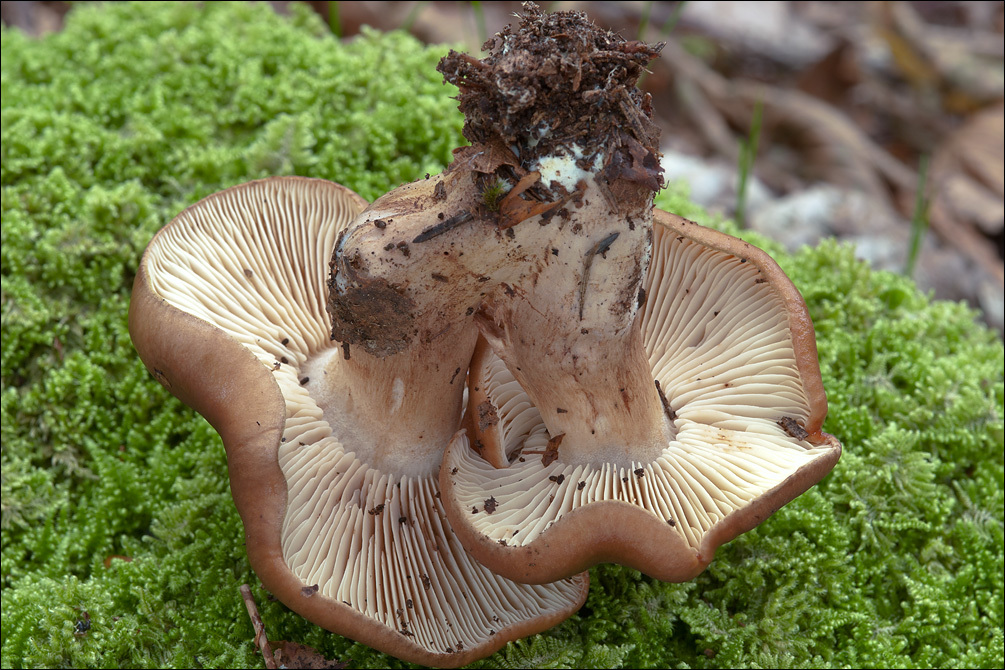
Slo.: rjavi zajek - syn.: Lyophyllum fumosum (Pers: Fr.) Orton, Lyophyllum loricatum (Fr.Khner), Lyophyllum aggregatum (Schaeffer) Khner, Lyophyllum conglobatum (Vit.) Moser, Lyophyllum cinerascens (Buill.) Giller - Habitat: mixed wood, Fagus sylvatica and Picea abies dominant trees; modestly steep, SE oriented mountain slope; shallow, skeletal soil layer, overgrown calcareous sand, stone and rocks; relatively dry and warm place; in shade; partly protected from direct rain by tree canopies; average precipitations ~ 3.000 mm/year, average temperature 7-9 deg C, elevation 585 m (1.920 feet), alpine phytogeographical region. - Substratum: forest soil, under Fagus sylvatica. - Comments: Lyophyllum decastes is actually an aggregate of quite differently looking mushrooms. Many species names have been used in this group. Authors still have different approach to them. I follow Krieglsteiner's view (Ref.2) (without my own arguments, but because it is the simplest for me), who considers Lyophyllum decastes, Lyophyllum fumosum, Lyophyllum loricatum, Lyophyllum aggregatum, Lyophyllum conglobatum and Lyophyllum cinerascens a single very variable species. Again and again fruit bodies are found with all possible intermediate properties forming an apparent continuum among these species. - Growing in groups of several fruit bodies on two places some 100 m apart (see also observation Bot_838/2014_DSC4273 in the same day); pileus diameter up to 5.2 cm, viscid with young fruit bodies; cuticle thick, rubbery, peels easily; stipe up to 4 cm tall and 1.5 cm in diameter; hollow with older fruit bodies; sporocarps markedly fleshy and firm; taste mild, mushroomy, after some time slightly bitter; smell indistinctive, almost none. - Herbarium: Mycotheca and lichen herbarium (LJU-Li) of Slovenian Forestry Institute, Vena pot 2, Ljubljana, Index Herbariorum LJF - Ref.: (1) G.J. Krieglsteiner (Hrsg.), Die Grosspilze Baden-Wrttembergs, Band 3., Ulmer (2001), p 307. (2) R. Phillips, Mushrooms, Macmillan (2006), p 114. (3) S. Buczacki, Collins Fungi Guide, Collins (2012), p 208. (4) J. Breitenbach, F. Kraenzlin, Eds., Fungi of Switzerland, Vol.3. Verlag Mykologia (1984), p 220. (5) R.M. Daehncke, 1200 Pilze in Farbfotos, AT Verlag (2009), p 275. (6) D. Arora, Mushrooms Demystified, Ten Speed Press, Berkeley (1986), p 174.
-
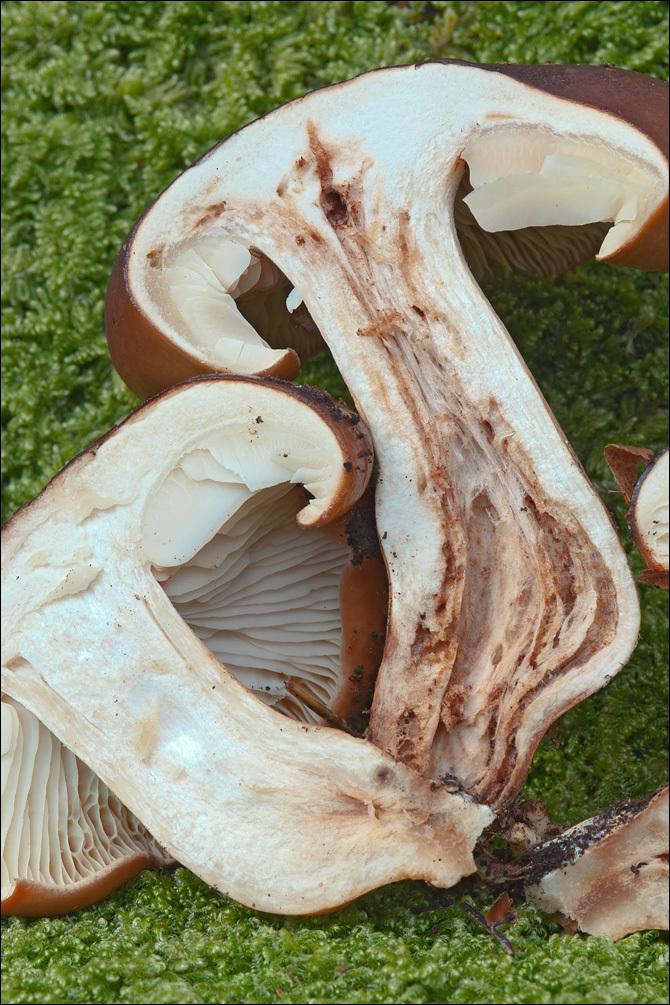
Slo.: rjavi zajek - syn.: Lyophyllum fumosum (Pers: Fr.) Orton, Lyophyllum loricatum (Fr.Khner), Lyophyllum aggregatum (Schaeffer) Khner, Lyophyllum conglobatum (Vit.) Moser, Lyophyllum cinerascens (Buill.) Giller - Habitat: mixed wood, Fagus sylvatica and Picea abies dominant trees; modestly steep, SE oriented mountain slope; shallow, skeletal soil layer, overgrown calcareous sand, stone and rocks; relatively dry and warm place; in shade; partly protected from direct rain by tree canopies; average precipitations ~ 3.000 mm/year, average temperature 7-9 deg C, elevation 585 m (1.920 feet), alpine phytogeographical region. - Substratum: forest soil, under Fagus sylvatica. - Comments: Lyophyllum decastes is actually an aggregate of quite differently looking mushrooms. Many species names have been used in this group. Authors still have different approach to them. I follow Krieglsteiner's view (Ref.2) (without my own arguments, but because it is the simplest for me), who considers Lyophyllum decastes, Lyophyllum fumosum, Lyophyllum loricatum, Lyophyllum aggregatum, Lyophyllum conglobatum and Lyophyllum cinerascens a single very variable species. Again and again fruit bodies are found with all possible intermediate properties forming an apparent continuum among these species. - Growing in groups of several fruit bodies on two places some 100 m apart (see also observation Bot_838/2014_DSC4273 in the same day); pileus diameter up to 5.2 cm, viscid with young fruit bodies; cuticle thick, rubbery, peels easily; stipe up to 4 cm tall and 1.5 cm in diameter; hollow with older fruit bodies; sporocarps markedly fleshy and firm; taste mild, mushroomy, after some time slightly bitter; smell indistinctive, almost none. - Herbarium: Mycotheca and lichen herbarium (LJU-Li) of Slovenian Forestry Institute, Vena pot 2, Ljubljana, Index Herbariorum LJF - Ref.: (1) G.J. Krieglsteiner (Hrsg.), Die Grosspilze Baden-Wrttembergs, Band 3., Ulmer (2001), p 307. (2) R. Phillips, Mushrooms, Macmillan (2006), p 114. (3) S. Buczacki, Collins Fungi Guide, Collins (2012), p 208. (4) J. Breitenbach, F. Kraenzlin, Eds., Fungi of Switzerland, Vol.3. Verlag Mykologia (1984), p 220. (5) R.M. Daehncke, 1200 Pilze in Farbfotos, AT Verlag (2009), p 275. (6) D. Arora, Mushrooms Demystified, Ten Speed Press, Berkeley (1986), p 174.
-
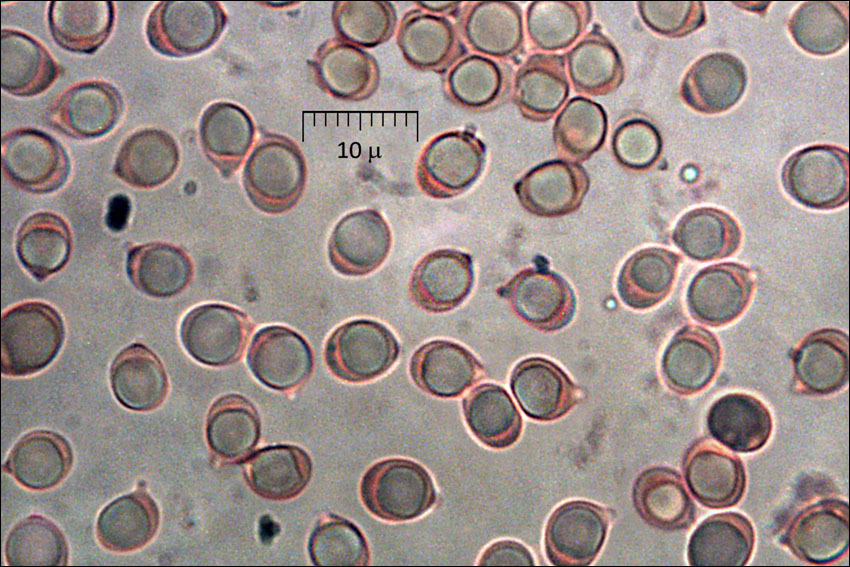
Slo.: rjavi zajek - syn.: Lyophyllum fumosum (Pers: Fr.) Orton, Lyophyllum loricatum (Fr.Khner), Lyophyllum aggregatum (Schaeffer) Khner, Lyophyllum conglobatum (Vit.) Moser, Lyophyllum cinerascens (Buill.) Giller - Habitat: mixed wood, Fagus sylvatica and Picea abies dominant trees; modestly steep, SE oriented mountain slope; shallow, skeletal soil layer, overgrown calcareous sand, stone and rocks; relatively dry and warm place; in shade; partly protected from direct rain by tree canopies; average precipitations ~ 3.000 mm/year, average temperature 7-9 deg C, elevation 600 m (1.970 feet), alpine phytogeographical region. - Substratum: forest soil. - Comments: Growing in groups of several fruit bodies on two places some 100 m apart (see also observation Bot_838/2014_DSC4296 in the same day); pileus diameter up to 5 cm, viscid with young fruit bodies; cuticle thick, rubbery, peels easily; stipe up to 4 cm tall and 1.4 cm in diameter; sporocarps markedly fleshy and firm; taste mild, mushroomy; smell indistinctive, almost none; SP abundant but only after two days of collecting, yellowish-beige with slight green tint, oac13. - Spores smooth, subglobose. Dimensions: 5.8 [6.3 ; 6.6] 7.1 x 4.6 [5.1 ; 5.3] 5.8 microns; Q = 1.2 [1.23 ; 1.26] 1.3; N = 37; C = 95%; Me = 6.5 x 5.2 microns; Qe = 1.2. Olympus CH20, NEA 100x/1.25, magnification 1.000 x, oil, in water, Congo red; live material. AmScope MA500 digital camera. - Ref.: (1) G.J. Krieglsteiner (Hrsg.), Die Grosspilze Baden-Wrttembergs, Band 3., Ulmer (2001), p 307. (2) R. Phillips, Mushrooms, Macmillan (2006), p 114. (3) S. Buczacki, Collins Fungi Guide, Collins (2012), p 208. (4) J. Breitenbach, F. Kraenzlin, Eds., Fungi of Switzerland, Vol.3. Verlag Mykologia (1984), p 220. (5) R.M. Daehncke, 1200 Pilze in Farbfotos, AT Verlag (2009), p 275. (6) D. Arora, Mushrooms Demystified, Ten Speed Press, Berkeley (1986), p 174.
-
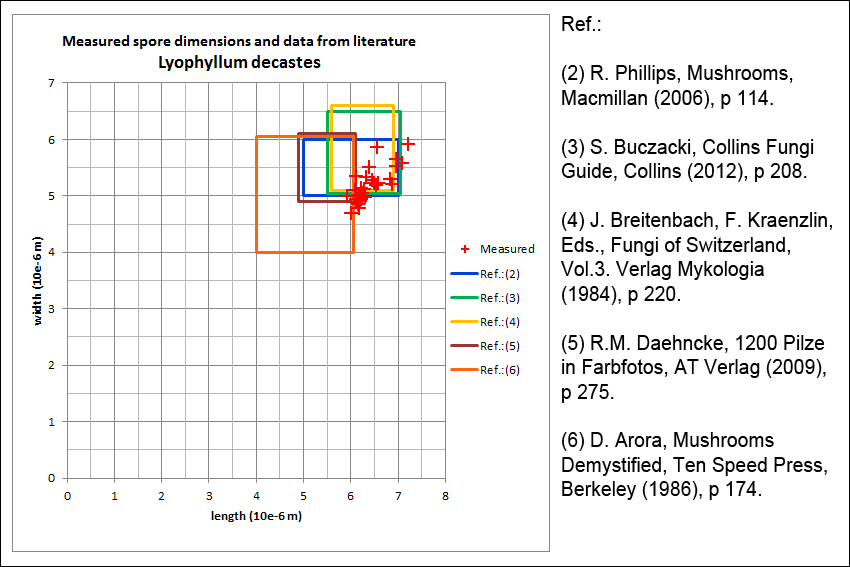
Slo.: rjavi zajek - syn.: Lyophyllum fumosum (Pers: Fr.) Orton, Lyophyllum loricatum (Fr.Khner), Lyophyllum aggregatum (Schaeffer) Khner, Lyophyllum conglobatum (Vit.) Moser, Lyophyllum cinerascens (Buill.) Giller - Habitat: mixed wood, Fagus sylvatica and Picea abies dominant trees; modestly steep, SE oriented mountain slope; shallow, skeletal soil layer, overgrown calcareous sand, stone and rocks; relatively dry and warm place; in shade; partly protected from direct rain by tree canopies; average precipitations ~ 3.000 mm/year, average temperature 7-9 deg C, elevation 600 m (1.970 feet), alpine phytogeographical region. - Substratum: forest soil. - Comments: Growing in groups of several fruit bodies on two places some 100 m apart (see also observation Bot_838/2014_DSC4296 in the same day); pileus diameter up to 5 cm, viscid with young fruit bodies; cuticle thick, rubbery, peels easily; stipe up to 4 cm tall and 1.4 cm in diameter; sporocarps markedly fleshy and firm; taste mild, mushroomy; smell indistinctive, almost none; SP abundant but only after two days of collecting, yellowish-beige with slight green tint, oac13. - Spores smooth, subglobose. Dimensions: 5.8 [6.3 ; 6.6] 7.1 x 4.6 [5.1 ; 5.3] 5.8 microns; Q = 1.2 [1.23 ; 1.26] 1.3; N = 37; C = 95%; Me = 6.5 x 5.2 microns; Qe = 1.2. Olympus CH20, NEA 100x/1.25, magnification 1.000 x, oil, in water, Congo red; live material. AmScope MA500 digital camera. - Ref.: (1) G.J. Krieglsteiner (Hrsg.), Die Grosspilze Baden-Wrttembergs, Band 3., Ulmer (2001), p 307. (2) R. Phillips, Mushrooms, Macmillan (2006), p 114. (3) S. Buczacki, Collins Fungi Guide, Collins (2012), p 208. (4) J. Breitenbach, F. Kraenzlin, Eds., Fungi of Switzerland, Vol.3. Verlag Mykologia (1984), p 220. (5) R.M. Daehncke, 1200 Pilze in Farbfotos, AT Verlag (2009), p 275. (6) D. Arora, Mushrooms Demystified, Ten Speed Press, Berkeley (1986), p 174.
-
-
-
-

Slo.: rjavi zajek - syn.: Lyophyllum fumosum (Pers: Fr.) Orton, Lyophyllum loricatum (Fr.Khner), Lyophyllum aggregatum (Schaeffer) Khner, Lyophyllum conglobatum (Vit.) Moser, Lyophyllum cinerascens (Buill.) Giller - Habitat: mixed wood, Fagus sylvatica and Picea abies dominant trees; modestly steep, SE oriented mountain slope; shallow, skeletal soil layer, overgrown calcareous sand, stone and rocks; relatively dry and warm place; in shade; partly protected from direct rain by tree canopies; average precipitations ~ 3.000 mm/year, average temperature 7-9 deg C, elevation 600 m (1.970 feet), alpine phytogeographical region. - Substratum: forest soil. - Comments: Growing in groups of several fruit bodies on two places some 100 m apart (see also observation Bot_838/2014_DSC4296 in the same day); pileus diameter up to 5 cm, viscid with young fruit bodies; cuticle thick, rubbery, peels easily; stipe up to 4 cm tall and 1.4 cm in diameter; sporocarps markedly fleshy and firm; taste mild, mushroomy; smell indistinctive, almost none; SP abundant but only after two days of collecting, yellowish-beige with slight green tint, oac13. - Spores smooth, subglobose. Dimensions: 5.8 [6.3 ; 6.6] 7.1 x 4.6 [5.1 ; 5.3] 5.8 microns; Q = 1.2 [1.23 ; 1.26] 1.3; N = 37; C = 95%; Me = 6.5 x 5.2 microns; Qe = 1.2. Olympus CH20, NEA 100x/1.25, magnification 1.000 x, oil, in water, Congo red; live material. AmScope MA500 digital camera. - Ref.: (1) G.J. Krieglsteiner (Hrsg.), Die Grosspilze Baden-Wrttembergs, Band 3., Ulmer (2001), p 307. (2) R. Phillips, Mushrooms, Macmillan (2006), p 114. (3) S. Buczacki, Collins Fungi Guide, Collins (2012), p 208. (4) J. Breitenbach, F. Kraenzlin, Eds., Fungi of Switzerland, Vol.3. Verlag Mykologia (1984), p 220. (5) R.M. Daehncke, 1200 Pilze in Farbfotos, AT Verlag (2009), p 275. S 5-6 (6) D. Arora, Mushrooms Demystified, Ten Speed Press, Berkeley (1986), p 174.
-
-
-
-
-
-
-
-
-
-
-

